From the May 2022 issue of Apollo. Preview and subscribe here.
Seventy-five years ago, in his studio in a Long Island barn, Jackson Pollock made the first of the works that would come to define him. These were (and are) known as ‘drip paintings’, although dripping was hardly to the point. As Hans Namuth was to record in his film of the artist at work in 1950, the artist flicked and spilled and flung diluted enamel paint at least as often as he dripped it. But ‘drip’ was the word that stuck to works such as Full Fathom Five (1947), thanks perhaps to the subeditor at Time magazine who, in the year of his death, bestowed upon Pollock the undying nickname ‘Jack the Dripper’.
Pollock had long since been anointed the crown prince of American painting by that critical kingmaker Clement Greenberg. In November 1943, in The Nation, Greenberg had rhapsodised the work in his first solo show, at Peggy Guggenheim’s Art of This Century gallery, as ‘among the strongest abstract paintings I have yet seen by an American’. In a taste of what was to come, he breezily noted that Pollock had ‘gone through the influences of Miró, Picasso and what not, and has come out on the other side’. He had, that is to say, taken what he wanted from Europe, and moved on. ‘He is liable to relapse into an influence,’ Greenberg added, darkly, ‘but if the times are propitious, it won’t be for long.’ It was he more than anyone who would see in Pollock’s work of the late 1940s an art that was essentially American.
Yet whether Pollock dripped (or flung or spilled) his paint was an irrelevance lent weight by Greenberg himself. Pollock’s paintings, he said, ‘eliminated the factor of manual skill and seemed to eliminate the factor of control along with it […] excluding anything that resembles control and order, not to mention skill’. If this misreading was that of what Greenberg sniffily called ‘the uninitiated eye’, it was nonetheless to become the standard line on Pollock. In trying to defend his hero’s rejection of skill, Greenberg turned him into raw instinct, tout court. This was what Hans Namuth also saw. His filming, he recalled, had lasted ‘perhaps half an hour’. In all that time, Pollock did not stop. How could one keep up this level of activity? Finally he said, ‘This is it.’ In fact, as Pollock later admitted, he had already finished the work he appeared to paint from new in Namuth’s film, reworking it for the camera. He was an altogether more knowing artist than the film-maker allowed, and a very much more sophisticated one.
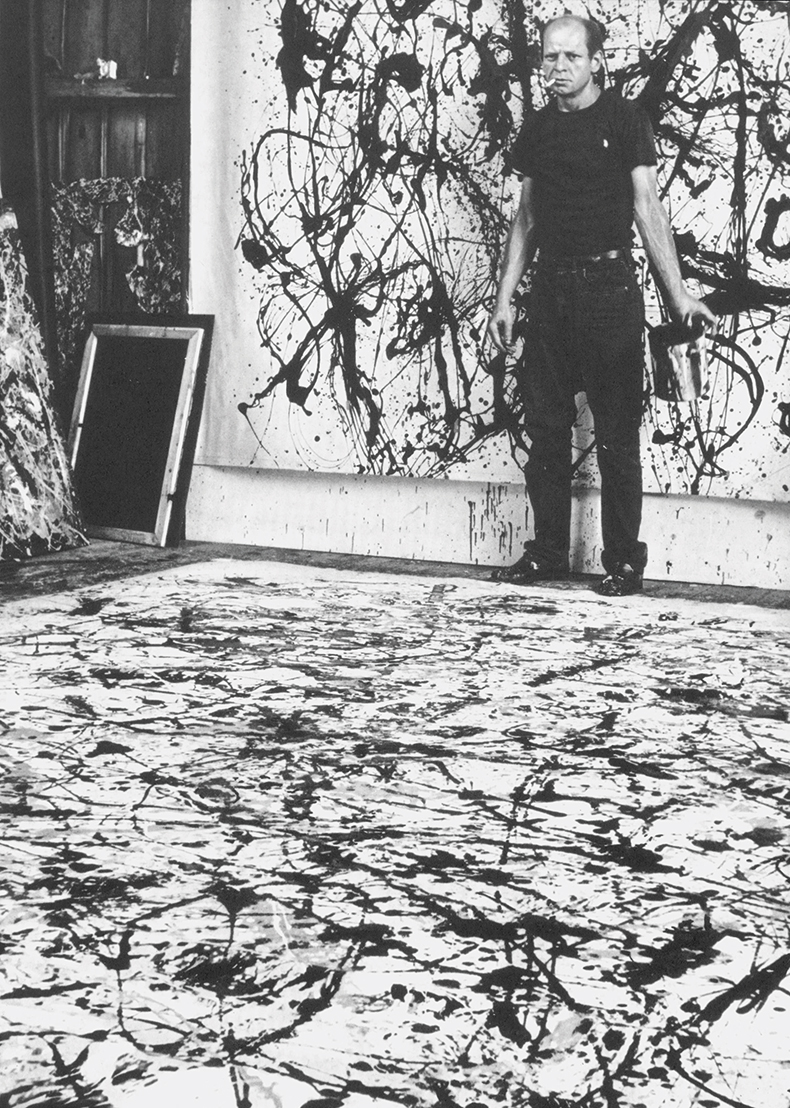
Jackson Pollock at work in his studio. © Granger Historical Picture Archive/Alamy Stock Photo
In 1998, the conservators of the Museum of Modern Art in New York undertook an exhaustive survey of the post-war Pollocks in their collection. This revealed a number of surprises. ‘The level of intentionality was the biggest,’ said MoMA’s chief conservator, James Coddington. ‘It just flew in the face of everything people have generally thought.’ He went on: ‘There’s a level of consciousness, intention, about [Pollock’s method] that liberates him to paint as unconsciously as he does […] a great deal of consciousness, balance, use of materials, and craft.’ He and a colleague had tried to make their own Pollock. Studying Namuth’s film, they pinned a primed canvas to the studio floor and poured paint on to it from a tin. ‘What this allows you to do is make an infinite line,’ Coddington recalled. ‘You can just go on and on and on. So these thin lines give one great control.’
Pollock himself would have agreed, had he been asked. In 1950, the year Namuth filmed him, Time magazine had run a piece on his art quoting the young Italian critic Bruno Alfieri, who had referred to the ‘chaos’ detectable in it. ‘It is easy to describe a [Pollock],’ Alfieri had said. ‘Think of a canvas surface on which the following have been poured: the contents of several tubes of paint of the best quality; sand, glass, various powders, pastels, gouache, charcoal […] It is important to state immediately that these “colors” have not been distributed according to a logical plan (whether naturalistic, abstract or otherwise). This is essential. Jackson Pollock’s paintings represent absolutely nothing: no facts, no ideas, no geometrical forms.’ Pollock’s response had been an enraged telegram to Time – ‘NO CHAOS DAMN IT’ – from which MoMA’s conservators took the name for their survey.
The story of Pollock’s drips, as he himself saw it, was thus one not of disorder but order. The various claimants to the title of his chief influencer – Max Ernst, William Baziotes, David Alfaro Siqueiros – had all eschewed control of their paint, splashing it from lazy Susans or dripping it from dangling tins with holes punched in them. The point of this was to relinquish intention, that snare of the conscious mind. Pollock’s approach to paint was quite different. His dripping might appear primal, at least to Greenberg, Namuth and Time magazine, but it was an appearance that he went about cultivating in an entirely methodical way. How methodical it was had also come as a surprise to MoMA’s conservators. ‘When you look at the surface of a Pollock, it is very abstracted,’ mused James Coddington, pondering X-rays of the drip paintings. ‘But when we can peer beneath the surface to see the underlying construction of the work, there you begin to see that the final surface organisation is actually pretty much laid down earlier on.’ The question, then, is not where Pollock had learned to drip, but where he had learned to give the impression of doing so. The answer to that, surprisingly, was in a studio run by an English printer.
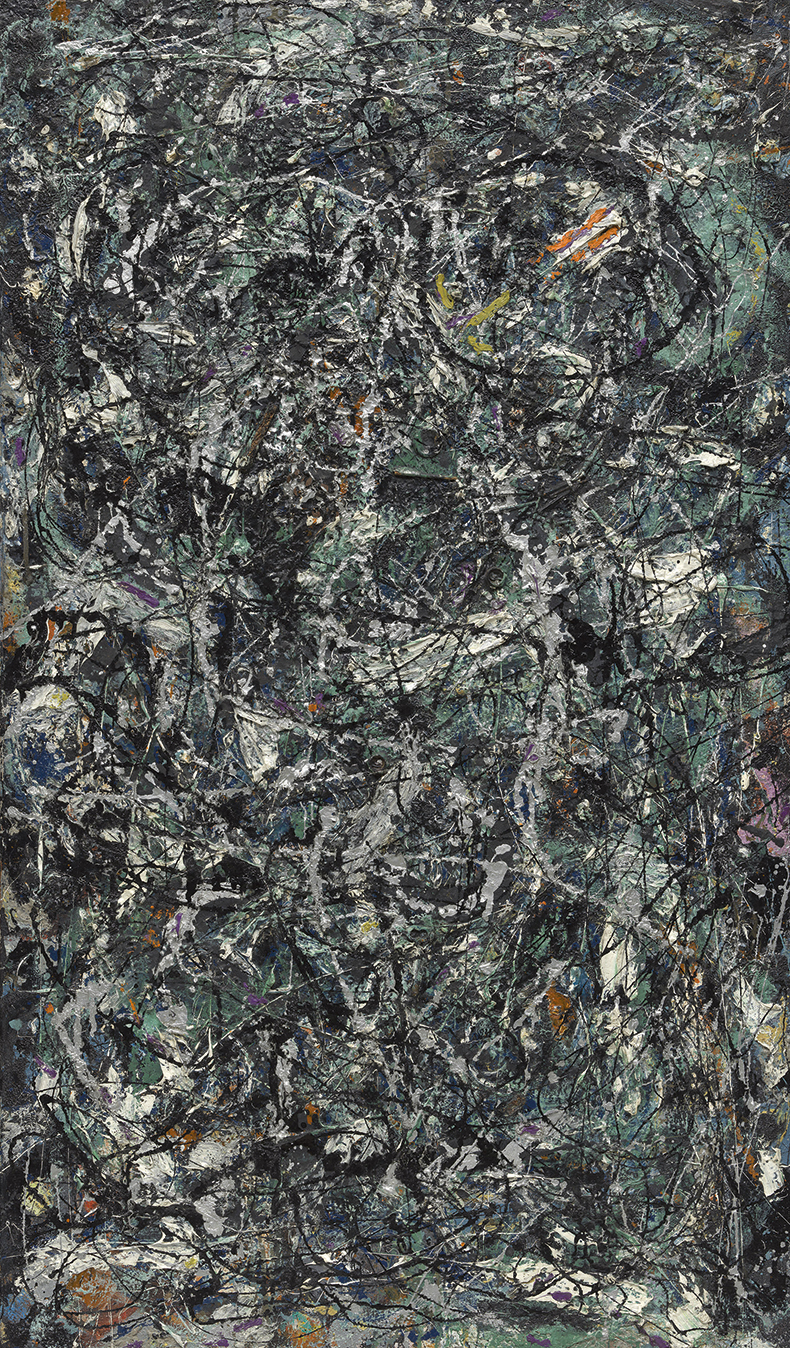
Full Fathom Five (1947), Jackson Pollock. Museum of Modern Art, New York.
Stanley William Hayter’s name is very well known in printmaking circles, rather less so outside of them. Born into a family of London artists in 1901, he had taken up science instead, setting off to what is now Iran as a geologist with the Anglo-Persian Oil Company. He had his first exhibition in 1926, of work produced in Abadan, while recovering in London from malaria. This did well enough for him to throw in his job, buy himself a motorcycle and head for Paris and the Académie Julian.
It was a meeting there with the Polish printmaker Józef Hecht that would set Hayter on the road he was to follow until his death 60 years later. For reasons that remain unclear, he decided to dedicate himself to rescuing intaglio printing from the desuetude into which it had fallen. In the 19th century, as artistic genius had come to be ever more closely equated with speed and spontaneity, engraving, that slowest and least spontaneous of art forms, had fallen out of favour. By 1926, it had been relegated to commercial studios, used in the reproduction of paintings or printing of books.
Hayter’s campaign to promote engraving as a modernist technique – in particular, to champion the use of the burin, an unwieldy instrument requiring not just skill but strength – seemed less quixotic than perverse. And yet it succeeded. By the mid 1930s, he had acquired a Montparnasse studio patronised by Picasso, Giacometti and Miró, not simply producing prints for these artists but teaching them to engrave for themselves. When war came, he moved this to New York, retaining the French name taken from its street number in rue Campagne-Première: Atelier 17. It would find a home on the top floor of the New School for Social Research – the University in Exile – a few blocks from Pollock’s flat.
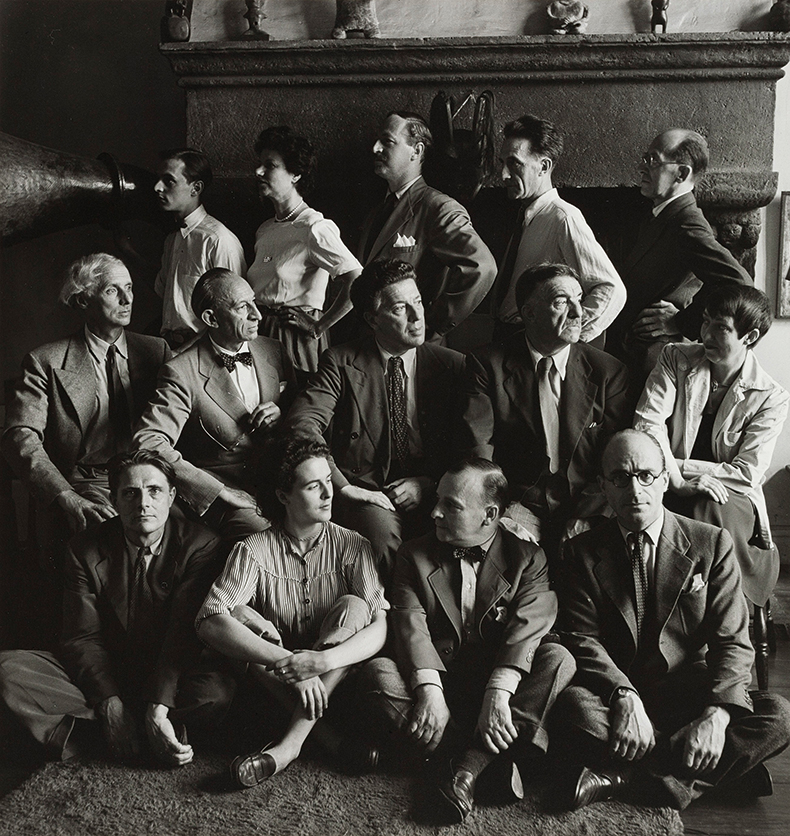
The Atelier 17 group, photographed in 1942, by Herman Landshoff. © bpk/Münchner Stadtmuseum, Sammlung Gotografie/Archiv Landshoff
Pollock will certainly have been aware of the studio from its opening in September 1940, this having generated a deal of excitement among young American artists; a thrill that only grew with the arrival, the following year, of the Parisians Hayter called his anciens – André Masson, Yves Tanguy and the ‘Pope’ of Surrealism, André Breton. ‘Eighth Street and Sixth Avenue was about the centre of the art world at that time,’ recalled the American sculptor Philip Pavia. ‘Of course, Paris was quite closed down. And we would see Zadkine when he passed and we’d start this discussion about Zadkine and Lipchitz.’ Jacques Lipchitz, too, would work at Hayter’s new atelier.
But there was a problem. Artists such as Pavia and Pollock did not speak French; the Parisians remained mulishly Francophone. Breton, in five years in New York, refused to learn a word of English, ‘de peur’, he said, ‘de polluer mon français’. In all the many letters Masson wrote in America, three English words appear, and those are ‘thank you’ and ‘chocolates’. The exiled Surrealists bitterly missed their nights at the Dôme and the Flore. ‘We have forbidden [ourselves] to talk about the past,’ Anaïs Nin, a fellow exile, wrote in her New York diary. ‘But Tanguy talks about the cafés in Paris, constantly recalls Montparnasse….[He] complains, “I used to live in the streets. Here, I never want to go out.”’ From their side, the young Americans were hungry to learn the things they had only been able to read about in the pages of Transition, published in English in Paris from 1927–38. Atelier 17, run by the bilingual Hayter, would be the place where those needs came together.
Pollock was not the only future New York School artist to make work at the atelier, at the New School or its later iteration across the road from his flat in East Eighth Street. Robert Motherwell, Mark Rothko and Willem de Kooning all did so, too, each producing there the only engravings they are known to have made. In 1947 at the Eighth Street atelier, Louise Bourgeois would make her breakthrough work, He Disappeared into Complete Silence, a suite of burin prints that prompted her move into sculpture. But it was Pollock who was most affected by his time at Atelier 17. Introduced to it by his printmaker friend Reuben Kadish, he worked there at night, furiously and alone, from the early autumn of 1944 to late spring 1945. ‘He didn’t work much with a lot of people in the print shop,’ Hayter recalled in the distant 1970s. ‘He’d come in at odd hours and at night when nobody else was there.’ Kadish said, ‘I inveigled Jackson into trying it because I thought his work had a kinship to Hayter’s prints.’ It was a likeness that had already been spotted by the Art News critic James Lane, who in 1942 compared the two men’s ‘general whirling figures’ – Pollock being then so little known that his name had been misspelled ‘Pollack’.
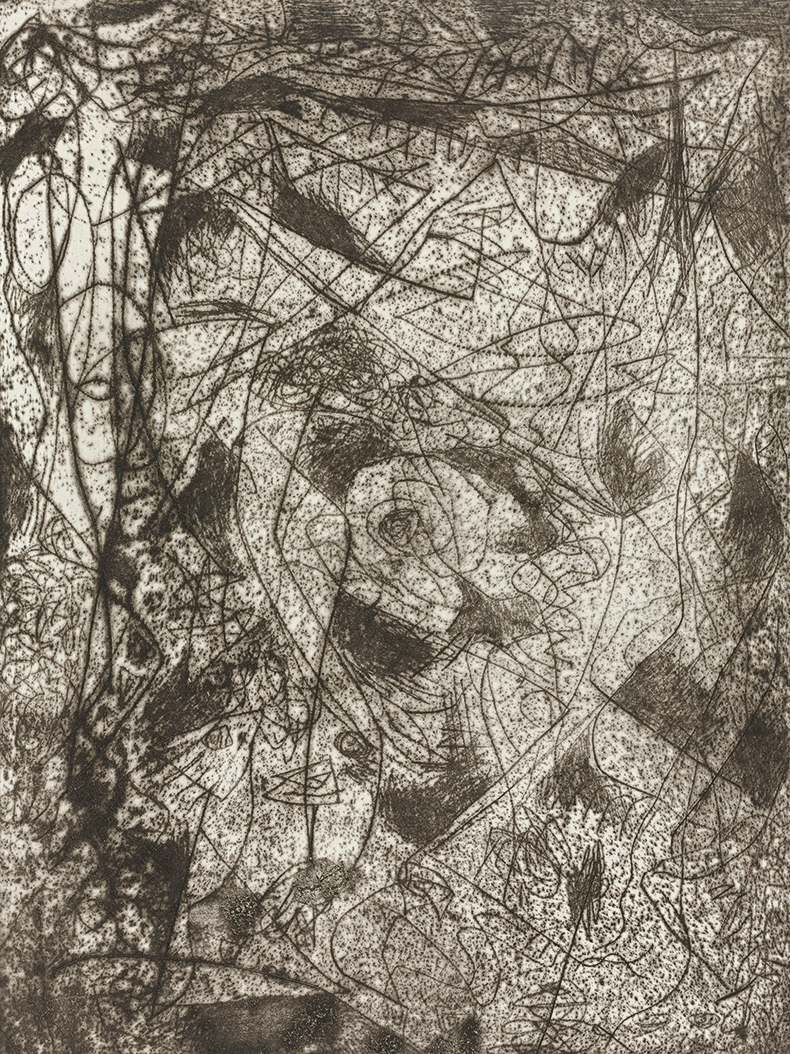
Untitled (6), c. 1944–45, Jackson Pollock. Museum of Modern Art, New York
If, sensitive to his own lack of skill, Pollock shunned other printmakers at the atelier, he certainly met one there: André Masson. Masson would later cite his own painting Pasiphaë (1943) as having influenced ‘un jeune peintre de l’époque, Pollock, devenu célèbre depuis’, but it was an earlier work, made at the atelier, that would most influence the young painter. This was Rape (1941), made within weeks of Masson’s arrival in America from Nazi-occupied France. His only automatic print, Rape marks a change in his thinking about automatism. Although not quite as freewheeling as it seems – the density of its lines is consistent, and few go over the margins – Rape sets out to look paroxysmal, out of control; to coin a phrase, an action etching. Masson’s print was left at Atelier 17 after its making, in a folio or hung on a wall. It seems certain that Pollock saw it there.
What may have excited him about the work was its own sense of excitement. Masson had made only one print at the Paris atelier, and that designed earlier, in his own studio. Now, in New York, he encountered Hayter’s teaching for the first time – his injunction to printmakers to ‘begin by destroying the plate’. The liberation this brought is clear from Rape, and would have been so to Pollock. Pollock’s own experience of printing had been woeful. ‘The problem with Jackson and printmaking is that you have to stick to the medium,’ said an earlier instructor, Theodore Wahl. ‘Jackson couldn’t stick to the medium.’ Now, in Hayter, he found a teacher whose only instruction was to treat the medium as he liked.
Pollock may have worked alone at Atelier 17, but he spent long hours with Hayter in the latter’s house on Waverly Place, visits that would continue until the older man returned to Paris in 1950. ‘When half drunk, Jack could talk intelligently about the source of inspiration and about the limits of working from the unconscious,’ Hayter said. He also understood what Pollock had been up to in his nights at Atelier 17. ‘A lot of our people, at this time, said. “This is nonsense. Anyone can do [what Pollock] is doing,”’ Hayter recalled. ‘And this infuriated me. So I said, “All right. Go to it. And I bet you not one of you can make one square inch of anything that can be mistaken for what Pollock’s done.” And they tried it… You can’t be fooled. It’s more than handwriting.’
What Hayter was talking about was a set of 11 plates, engraved by Pollock and each pulled once as an épreuve d’essai, or trial proof, by Reuben Kadish. The prints were never editioned; in 1945, the plates were taken by Pollock to his barn in Springs, NY, where nine survivors were rediscovered in 1966, a decade after his death. They were given to the Museum of Modern Art by Lee Krasner in 1969, together with Kadish’s prints.
What these show is extraordinary: Pollock, egged on by Hayter, attacking the plate from all sides, turning it as he goes, producing an all-over image that, in 1944, was entirely new to him but would be typical of his paintings of 1947–50. The first group of prints reworks experiments he was already making in paint, the second tries to come to terms with European masters such as Miró. It is in numbers 4 and 6 in the last group of untitled prints, now in MoMA’s collection, that Pollock finally treats the line as hermetic, a form with a rationale of its own that blurs the line between figure and ground.
In an article written the year before Pollock’s death, Hayter described the method he had passed on to him. ‘In line engraving with the burin the engraver drives a sharp tool against the turning plate,’ he said. ‘He has the sensation of navigating inside the web of his design which turns as the landscape seems to turn beneath a banking plane. He moves in depth. His experience remains visible.’ He might have been talking about Full Fathom Five. He understood, too, the link between Pollock’s prints and his drip paintings, begun 18 months later. Looking at one of the paintings, Hayter laughed: ‘This is the other side of the mirror! This was done with an open gesture like that, whereas [the prints were] done by a movement against the resistance of metal; and when it appears to move at enormous speed, it is actually moving very, very slowly.’ Among the other things that Pollock had learned at Atelier 17 was the art of deception, of methodical chaos.
Three decades after the death of his protégé, Hayter said, ‘Jack always claimed that he had two masters: Benton and me.’ The American Regionalist Thomas Hart Benton, Pollock’s professor at art school, had taught him the rules of painting. Hayter encouraged him to break them. That this has been largely forgotten is easy enough to understand: Hayter is known as a printmaker, although he saw himself primarily as a painter; Pollock’s plates remain little known; Hayter was European in a day when the writing of American art history was chauvinistic. But it does need to be remembered.
From the May 2022 issue of Apollo. Preview and subscribe here.
Unlimited access from just $16 every 3 months
Subscribe to get unlimited and exclusive access to the top art stories, interviews and exhibition reviews.

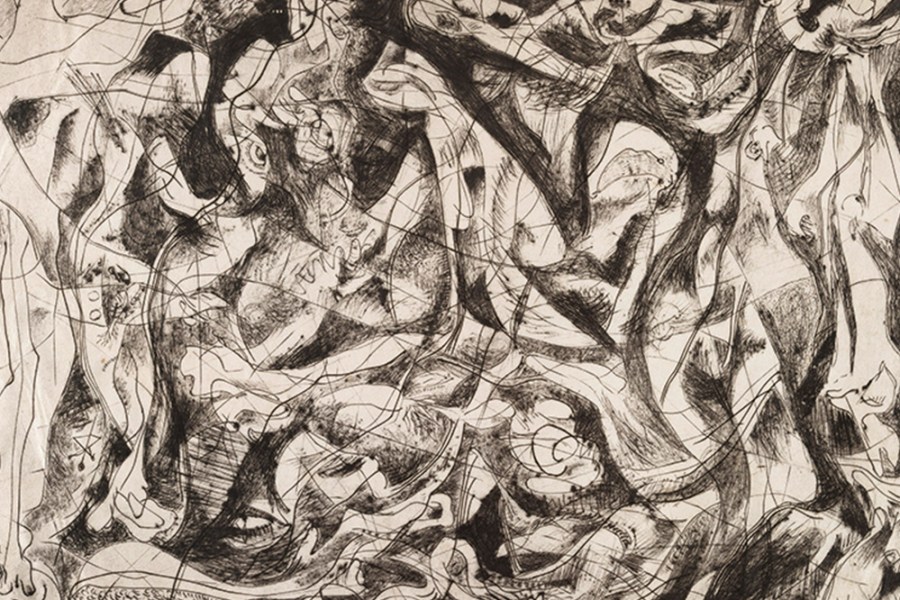
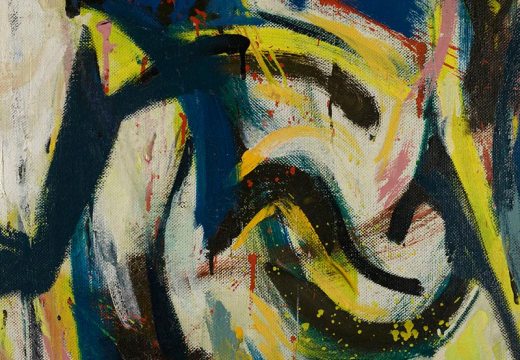
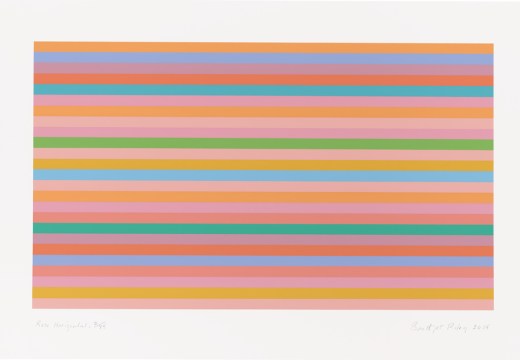
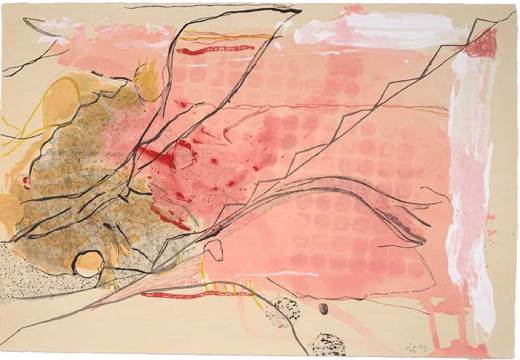









![Masterpiece [Re]discovery 2022. Photo: Ben Fisher Photography, courtesy of Masterpiece London](http://www.apollo-magazine.com/wp-content/uploads/2022/07/MPL2022_4263.jpg)
It’s time for the government of London to return to its rightful home